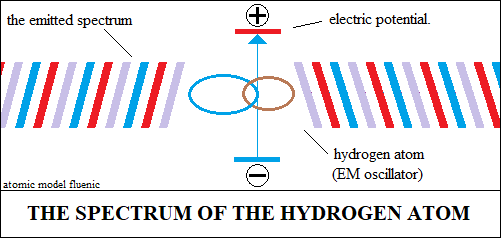The atomic
spectrum of hydrogen
The spectrum of EM oscillations emitted by hydrogen
was determined in the experiment as concretely as possible.
However, the experiment does not reveal how to produce the phenomenon.
Obviously, it occurs as a result of an interaction.
We interpret the vector interaction:
The hydrogen atom is a double oscillator, two vector circuits connected orthogonally,
like two chain links and called electric and magnetic.
The force of attraction between the polarities of vectors with opposite signs,
narrow down the circuit to the minimum size, like a centripetal force.
So we have two centripetal vector forces that are mutually generated.
When the force of one torus increases (size decreases),
the force of the other decreases (size increases) and vice versa.
The forces of the two tores thus oscillate,
reaching a balance of energy and minimum dimensions.
This is the fundamental frequency, the stability of the "EM" oscillator.
The oscillations are forces, which interacting with the neared EM environment.
The environment repeats the oscillation from close to close,
a propagation to the infinite (Mach)
When the oscillator is placed between two plates at an electric potential,
is produced the interaction:
Random interactions agitate the gas,
completing the spectrum with the large wavelengths.
The circuit of vectors between the plates compund with of an oscillator circuit.
The intensity of that circuit increases, goes out of balance
and the frequency of the oscillator is pushed towards zero, with each oscillation.
The amplitudes of the toruses (wavelength) vary simultaneously,
but in opposite directions - one decreases the other increases.
When the amplitude decreases, each oscillation
leaves behind footprint of the frequency.
The imprint being Faraday's induction, it changes its direction
of orientation and is propagated centrifugally in the EM medium.
It is exactly the emission phenomenon of an antenna.
The propagated fingerprints represent the EM spectrum
emitted bidirectionally by the hydrogen atom.

